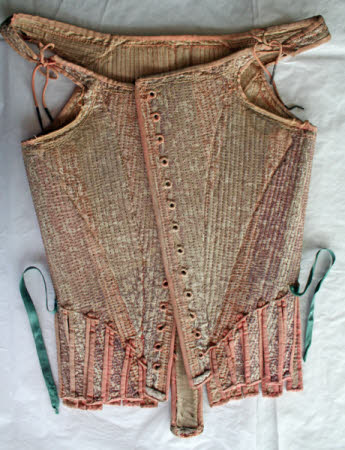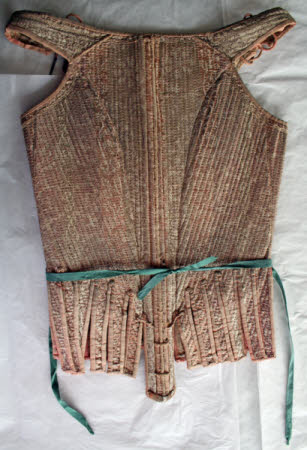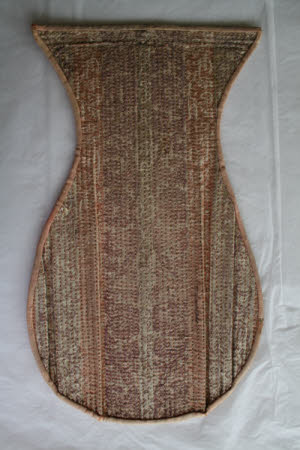Pregnancy stay
Category
Costume
Date
1665 - 1675
Materials
Linen, silk, leather, ribbon and baleen
Measurements
465 x 340 mm
Order this imageCollection
Claydon House, Buckinghamshire
NT 1446613
Caption
In the 17th century many married women experienced ten or more pregnancies. They therefore spent a considerable part of their lives expecting babies, in ‘confinement’ (recuperating after childbirth) or caring for them. The pregnancy stays or ‘bodies’ in the collection at Claydon were made for Mary Abell, Lady Verney (1641–1715), and are an exceptionally rare survival of a once commonly worn garment. Mary married Edmund Verney (1636–88), eldest son of Sir Ralph and Lady Mary Verney, in Westminster Abbey in 1662. The couple went on to have three children – Ralph, Edmund and Mary – between 1666 and 1675. Constructed from patterned pink silk and linen, the stays have strips of whale baleen hand stitched into them to provide firm but flexible support and to shape Mary’s figure. She would have worn her stays over the stomacher. This features a wide, lobed lower section, so that she could gradually loosen the laces as each of her pregnancies advanced, the flexible tabs along the bottom edge designed to spread out as her stomach expanded. Emma Slocombe
Summary
A pair of pregnancy stays made for and worn by Mary Verney, née Abell (1641-1715) between 1665 and 1675. The stays and stomacher are made of figured pink satin, layered with linen and lined with a herringbone twill linen, with edges and tabs bound in salmon pink ribbon. Both parts feature narrow, tightly stitched channels into which strips of whale baleen (also known as whalebone) have been inserted to give the garment its structure and form. The stays are made up of 10 panels and have adjustable shoulders with lace ties finished at each end with a metal aglet and 13 eyelets running down each side of the front opening where they would have originally been laced. A green satin ribbon attached at the waistline which ties at the front and back is likely to be a later addition.
Full description
Mary Verney's (1641-1715) stays c.1665-75, are an exceptionally rare survival of a once commonly worn garment, purpose-made and intended to adapt to the physical changes of advancing pregnancy. Mary Abell married Edmund Verney of Claydon, Buckinghamshire, in 1662 and wore the stays while pregnant with her three children, Ralph, Edmund and Mary. Fashioned from figured pink silk and linen, the stays are stiffened with whale baleen in stitched channels to provide firm but flexible support to shape for her figure. Mary would have worn her stays over the stomacher with its unique wide, lobed lower section, gradually loosening the laces as each of her pregnancies advanced. The flexible tabs along the bottom edge are designed to spread out as her stomach expanded. As the centre front opened out and the lacing spread, the lobed section of the stomacher bridged the widening gap and supported the lacing.
Provenance
Accepted by HM Government in lieu of inheritance tax and allocated to the National Trust for display at Claydon House, 2005.
Credit line
By descent in the Verney family; accepted by HM Government in lieu of inheritance tax and allocated to the National Trust for display at Claydon House, 2005.
Exhibition history
Portraying Pregnancy: From Holbein to Social Media , Foundling Museum, London, 2020
References
Hearn 2020: Karen Hearn, Portraying Pregnancy: from Holbein to Social Media, London: Paul Holberton Publishing in Association with the Foundling Museum, 2020, pp. 70-71, fig. 31. Bendall 2022: Sarah A. Bendall, Shaping Femininity: Foundation Garments, the Body and Women in Early Modern England, London, New York and Dublin 2022, pp. 206-211. Antrobus and Slocombe 2025: Helen Antrobus and Emma Slocombe, 100 Things to Wear: Fashion from the collections of the National Trust, National Trust 2025, pp. 48-49.


